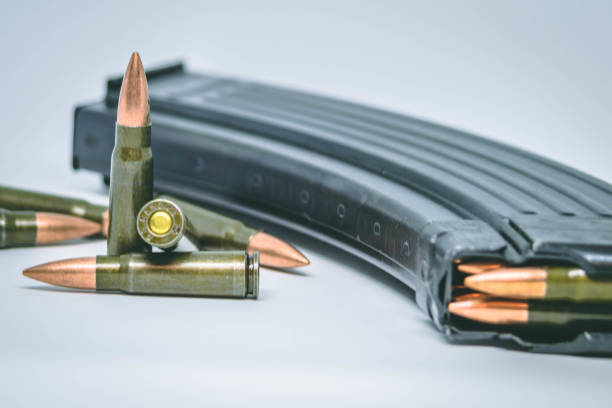
The AK-47 Bullet: Understanding Its Ballistics, History, and Impact
The AK-47, an iconic assault rifle, is inseparable from its ammunition: the 7.62x39mm AK-47 bullet. This article delves into the intricacies of the AK-47 bullet, exploring its history, ballistics, and the impact it has had on conflicts worldwide. Understanding the AK-47 bullet is crucial for anyone seeking knowledge about modern weaponry and its effects.
A Brief History of the 7.62x39mm Round
The 7.62x39mm round was developed in the Soviet Union during World War II. The Soviets recognized the need for an intermediate cartridge, something more powerful than a pistol round but less cumbersome than a full-power rifle cartridge. This led to the creation of the 7.62x39mm, which quickly became the standard ammunition for the AK-47 rifle, designed by Mikhail Kalashnikov. The AK-47 bullet and rifle combination proved to be a revolutionary force in warfare.
Ballistics and Specifications of the AK-47 Bullet
The standard 7.62x39mm AK-47 bullet typically weighs around 123 grains (8 grams). It has a muzzle velocity of approximately 2,330 feet per second (710 meters per second). These specifications contribute to its effective range, which is around 350-400 meters for aimed fire. The AK-47 bullet is known for its significant stopping power at close to medium ranges.
Bullet Design and Construction
The AK-47 bullet typically features a steel core, encased in a copper or bi-metal jacket. This design enhances its penetration capabilities, making it effective against light cover and body armor. The bullet’s shape is generally spitzer, which aids in aerodynamic stability and accuracy. Various types of AK-47 bullets exist, including tracer rounds, armor-piercing rounds, and hollow-point rounds, each designed for specific purposes.
The Impact of the AK-47 Bullet on Warfare
The AK-47 and its associated AK-47 bullet have had a profound impact on warfare, particularly in asymmetric conflicts. Its simplicity, reliability, and affordability have made it a favorite among guerrilla fighters, insurgents, and even some military forces around the world. The AK-47 bullet‘s effectiveness in close-quarters combat has contributed to its widespread use in urban warfare scenarios. The proliferation of the AK-47 has also led to humanitarian concerns due to its role in armed conflicts and violence in many regions.
Comparing the AK-47 Bullet to Other Ammunition
The 7.62x39mm AK-47 bullet is often compared to other intermediate cartridges, such as the 5.56x45mm NATO round used in the M16 and M4 rifles. The 5.56mm round generally has a flatter trajectory and higher velocity, making it more effective at longer ranges. However, the 7.62x39mm AK-47 bullet delivers more energy on target, providing greater stopping power at shorter distances. The choice between the two often depends on the specific tactical situation and the user’s preferences. [See also: 5.56 vs 7.62: A Ballistic Comparison]
AK-47 Bullet vs. Other Rifle Rounds
Compared to larger rifle rounds like the 7.62x51mm NATO, the AK-47 bullet offers a better balance between power and controllability. Full-power rifle rounds deliver significantly more energy but are often more difficult to control in automatic fire. The AK-47 bullet provides a manageable recoil, allowing for faster follow-up shots and better accuracy in sustained fire.
Legal and Ethical Considerations Surrounding the AK-47 Bullet
The widespread availability of the AK-47 and its AK-47 bullet has raised numerous legal and ethical concerns. In many countries, the possession and sale of AK-47s are strictly regulated due to their potential for misuse. The use of certain types of AK-47 bullets, such as armor-piercing or expanding rounds, is also restricted under international law. The ethical implications of using the AK-47 in conflict zones are significant, particularly concerning civilian casualties and the potential for human rights abuses.
The Future of the AK-47 Bullet
Despite its age, the 7.62x39mm AK-47 bullet remains a relevant and widely used cartridge. While newer ammunition types and weapon systems have emerged, the AK-47’s reliability, affordability, and effectiveness continue to ensure its place in modern arsenals. Ongoing research and development efforts are focused on improving the performance of the AK-47 bullet, including enhancements to its accuracy, penetration, and terminal ballistics. [See also: Modern Assault Rifle Ammunition Development]
Innovations in AK-47 Bullet Technology
Modern advancements in bullet design and manufacturing techniques are leading to improved versions of the AK-47 bullet. These innovations include the use of new materials, such as tungsten alloys, to enhance penetration, and the development of more effective hollow-point designs for increased stopping power. The integration of advanced propellants and primer technologies is also contributing to improved accuracy and reliability. These advancements aim to keep the AK-47 bullet competitive in an evolving landscape of firearms technology.
Conclusion
The AK-47 bullet, specifically the 7.62x39mm round, has played a pivotal role in shaping modern warfare. Its combination of affordability, reliability, and effectiveness has made it a ubiquitous presence on battlefields around the world. While newer ammunition types and weapon systems have emerged, the AK-47 bullet continues to be a significant factor in conflicts worldwide. Understanding its history, ballistics, and impact is essential for anyone seeking to comprehend the dynamics of modern warfare. The enduring legacy of the AK-47 bullet ensures that it will remain a topic of discussion and analysis for years to come. From its initial development to its widespread use in various conflicts, the AK-47 bullet continues to be a symbol of both technological innovation and the harsh realities of armed conflict. The ongoing debates surrounding its legal and ethical implications highlight the complex relationship between technology and society. As technology advances, the AK-47 bullet will likely continue to evolve, adapting to the changing demands of modern warfare. The future of the AK-47 bullet will depend on ongoing research and development efforts, as well as the evolving geopolitical landscape.
